Pandas Concat vs Append
In data analysis, combining or merging datasets is a common task. Pandas, a powerful Python library, provides various functions to perform these operations, among which concat and append are widely used. This article explores the differences and use-cases of the concat and append functions in Pandas, providing detailed examples to illustrate their usage.
Introduction to Pandas
Pandas is an open-source data manipulation and analysis tool built on top of the Python programming language. It offers data structures and operations for manipulating numerical tables and time series. The primary data structure in Pandas is the DataFrame, which can be thought of as a relational data table, with rows and columns.
Concatenation with pd.concat
Concatenation is the process of joining two or more dataframes along an axis. Pandas provides the pd.concat() function to handle such operations.
Basic Concatenation
The simplest form of concatenation is appending dataframes vertically or horizontally.
Example 1: Vertical Concatenation
import pandas as pd
df1 = pd.DataFrame({
"A": ["A0", "A1", "A2"],
"B": ["B0", "B1", "B2"]
}, index=[0, 1, 2])
df2 = pd.DataFrame({
"A": ["A3", "A4", "A5"],
"B": ["B3", "B4", "B5"]
}, index=[3, 4, 5])
result = pd.concat([df1, df2])
print(result)
Output:
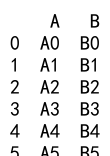
Example 2: Horizontal Concatenation
import pandas as pd
df1 = pd.DataFrame({
"A": ["A0", "A1", "A2"],
"B": ["B0", "B1", "B2"]
})
df2 = pd.DataFrame({
"C": ["C0", "C1", "C2"],
"D": ["D0", "D1", "D2"]
})
result = pd.concat([df1, df2], axis=1)
print(result)
Output:
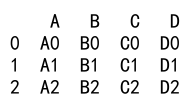
Handling Indexes
When concatenating dataframes, handling indexes properly is crucial to avoid data misalignment.
Example 3: Ignoring the Index
import pandas as pd
df1 = pd.DataFrame({
"A": ["A0", "A1", "A2"],
"B": ["B0", "B1", "B2"]
})
df2 = pd.DataFrame({
"A": ["A3", "A4", "A5"],
"B": ["B3", "B4", "B5"]
})
result = pd.concat([df1, df2], ignore_index=True)
print(result)
Output:
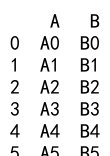
Concatenation with MultiIndex
For more complex data structures, Pandas can concatenate using a MultiIndex.
Example 4: Creating a MultiIndex on Concatenation
import pandas as pd
df1 = pd.DataFrame({
"A": ["A0", "A1", "A2"],
"B": ["B0", "B1", "B2"]
})
df2 = pd.DataFrame({
"A": ["A3", "A4", "A5"],
"B": ["B3", "B4", "B5"]
})
result = pd.concat([df1, df2], keys=['x', 'y'])
print(result)
Output:
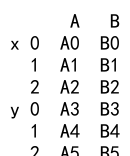
Appending Data with df.append
The append function is a shortcut to concatenate along axis=0, specifically designed for cases where you are adding a single row or a series of rows to a DataFrame.
Basic Appending
Appending is straightforward and can be used to add rows to a DataFrame.
Example 5: Appending Rows
import pandas as pd
df = pd.DataFrame({
"A": ["A0", "A1", "A2"],
"B": ["B0", "B1", "B2"]
})
new_row = pd.Series(["A3", "B3"], index=["A", "B"])
result = df._append(new_row, ignore_index=True)
print(result)
Output:
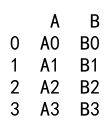
Appending Multiple DataFrames
While append can be used to add multiple dataframes, it is essentially a shortcut for pd.concat.
Example 6: Appending Multiple DataFrames
import pandas as pd
df1 = pd.DataFrame({
"A": ["A0", "A1", "A2"],
"B": ["B0", "B1", "B2"]
})
df2 = pd.DataFrame({
"A": ["A3", "A4", "A5"],
"B": ["B3", "B4", "B5"]
})
result = df1._append(df2, ignore_index=True)
print(result)
Output:
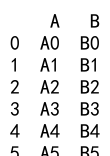
Performance Considerations
When dealing with large datasets or performing multiple append operations, it is important to consider the performance implications.
Example 7: Performance of append vs concat
import pandas as pd
import time
# Creating large DataFrames
df1 = pd.DataFrame({
"A": ["A" + str(i) for i in range(5000)],
"B": ["B" + str(i) for i in range(5000)]
})
df2 = pd.DataFrame({
"A": ["A" + str(i) for i in range(5000, 10000)],
"B": ["B" + str(i) for i in range(5000, 10000)]
})
# Timing append
start_time = time.time()
result_append = df1
for _ in range(10):
result_append = result_append._append(df2, ignore_index=True)
end_time = time.time()
print("Append time:", end_time - start_time)
# Timing concat
start_time = time.time()
result_concat = pd.concat([df1] + [df2] * 10, ignore_index=True)
end_time = time.time()
print("Concat time:", end_time - start_time)
Output:

Pandas Concat vs Append Conclusion
Both concat and append are useful functions in Pandas for combining dataframes. While append is convenient for adding rows to a DataFrame, concat provides more flexibility and efficiency, especially when dealing with larger datasets or complex data structures. Understanding the differences and appropriate use-cases of these functions can significantly enhance your data manipulation capabilities in Python.
This guide has provided an in-depth look at the functionalities and differences between concat and append with practical examples. By mastering these techniques, you can handle a wide range of data merging scenarios in your data analysis projects.
 Pandas Dataframe
Pandas Dataframe